SB Television
Emirates Team New Zealand Two for Two in America’s Cup Opener
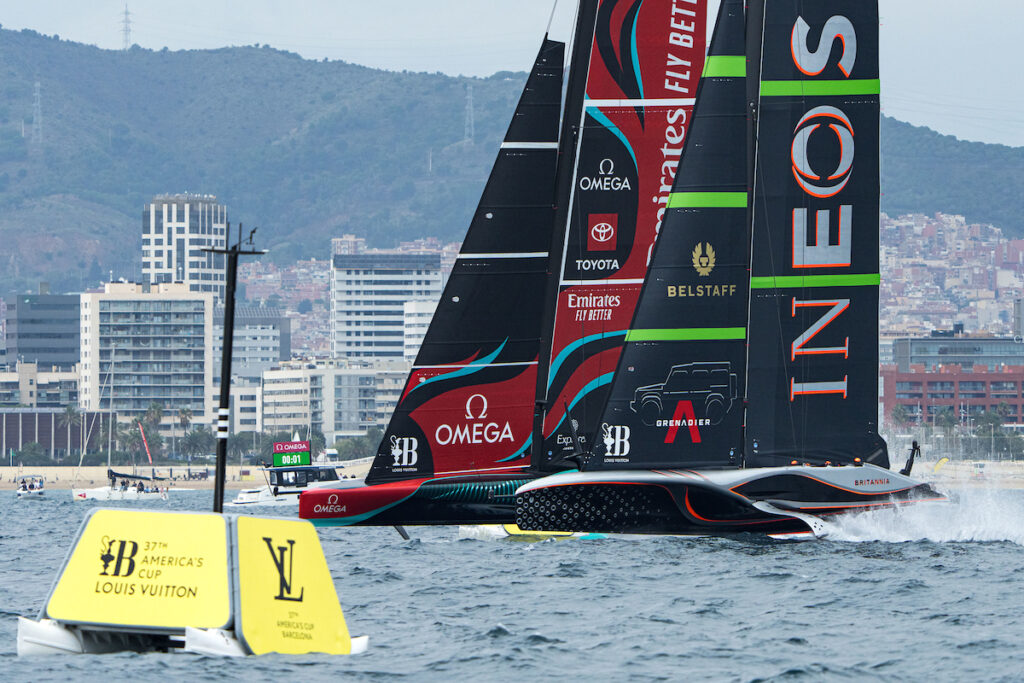 INEOS Britannia and Emirates Team New Zealand charge across the start of Race 2 of the Louis Vuitton 37th America’s Cup in Barcelona.
Ian Roman/America’s Cup
INEOS Britannia and Emirates Team New Zealand charge across the start of Race 2 of the Louis Vuitton 37th America’s Cup in Barcelona.
Ian Roman/America’s Cup
There can be a knock-on effect in every sailboat race; a winch override, a stuck jammer, a slip of the sheet, or any other countless things that can lose a lane or a shift, but a faulty lithium-ion battery in the first race of the America’s Cup is kind of a major knock.
That’s where INEOS Britannia found itself in the stressful minutes ahead of its first match of the Louis Vuitton 37th America’s Cup Match, with its electronics team scrambling to replace one of the British boat’s batteries, which then had them rushing with their chase boat tow into the pre-start and ultimately 40 seconds late for their starboard entry.
.embed-container { position: relative; padding-bottom: 56.25%; height: 0; overflow: hidden; max-width: 100%; } .embed-container iframe, .embed-container object, .embed-container embed { position: absolute; top: 0; left: 0; width: 100%; height: 100%; }“Right at the last minute, the battery started giving faulty readings, which means it’s not safe,” INEOS Britannia skipper Ben Ainslie said after racing, pointing to a temperature warning. “These lithium-ion batteries are generally reliable, but trust me, as we’ve seen before, you don’t want one of those going bad.”
Fortunate to complete the battery swap in time and with the wind hovering just above the bottom of the wind range in the starting area, the British struggled to take off after cutting the chase boat tow.
“We were in a massive lull so that kind of set us back even further,” says INEOS Britannia cyclor Neil Hunter. We were definitely up against it and were lucky to be able to enter at a half-decent time. Definitely not the way we wanted to start and this boat has been—touch wood—incredibly reliable and that’s the first little issue we’ve seen.”
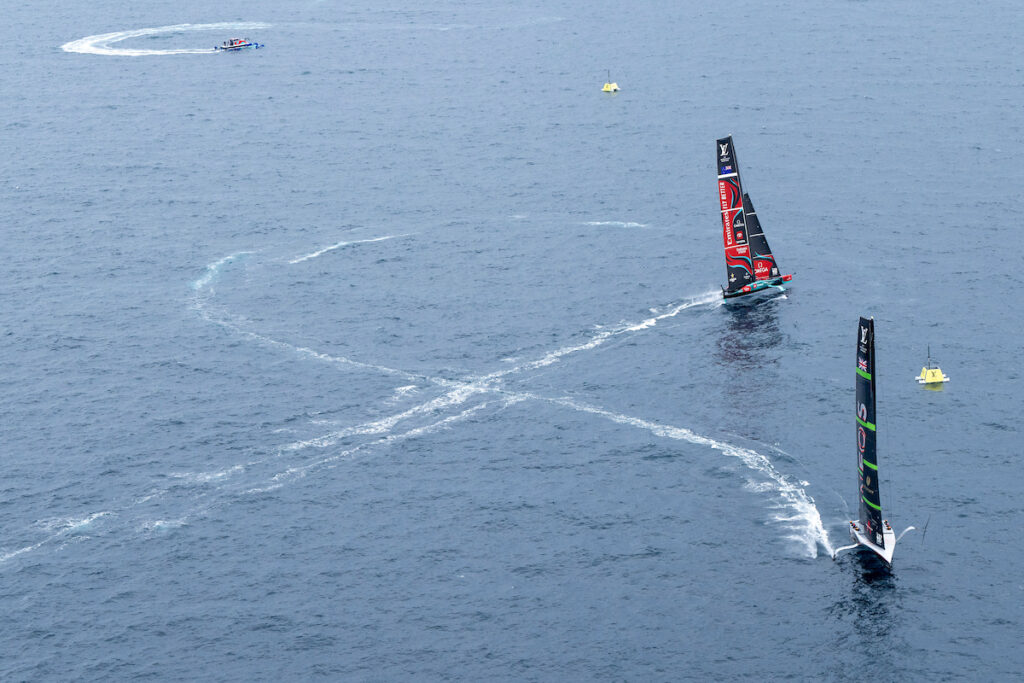 Emirates Team New Zealand took advantage of INEOS’s late start in the first race of the Match.
Ricardo Pinto/America’s Cup
Emirates Team New Zealand Clinical In Race 1
Emirates Team New Zealand took advantage of INEOS’s late start in the first race of the Match.
Ricardo Pinto/America’s Cup
Emirates Team New Zealand Clinical In Race 1
But by the time INEOS entered they were adlibbing through an unfamiliar pre-start engagement with Emirates Team New Zealand, which had cruised in on time and tacked in front of the British while they were still trying to complete their entry. So much for the starboard advantage.
The New Zealanders played fast and loose with the British in the final minute and had an immediate jump off the start, a good 2 knots faster, and controlled the match from there, covering and bouncing INEOS to round through the first gate with a 24-second advantage. That advantage quickly turned to a 300-plus meter lead that INEOS was able to cut into with a streak of breeze on the right side of the course (looking upwind).
It was 15 seconds at the next gate, and Ainslie followed and split.
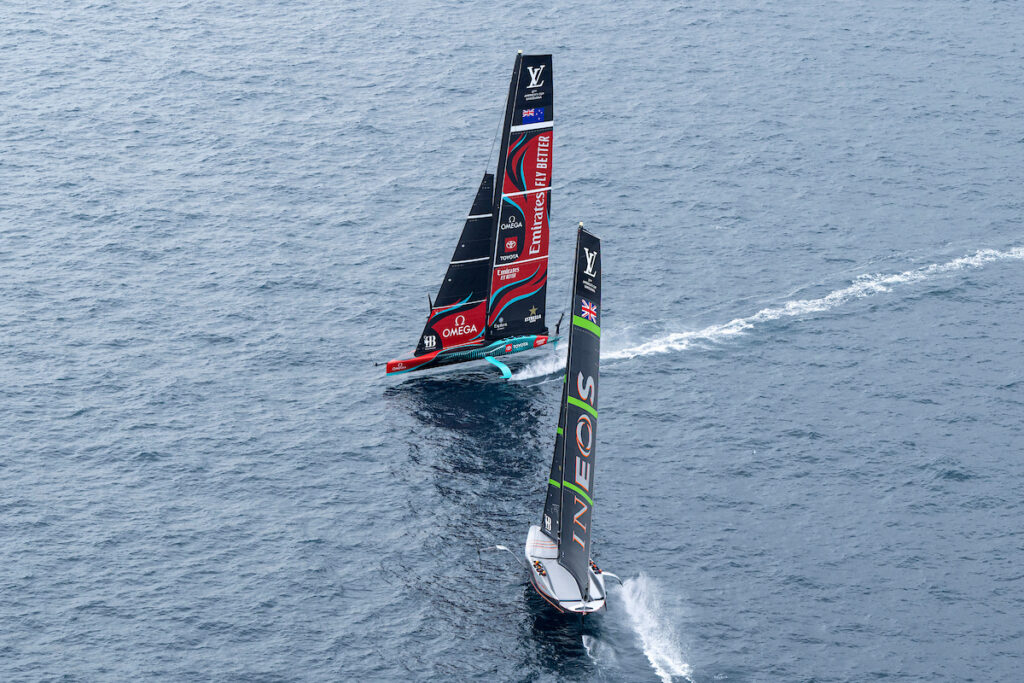 Emirates Team New Zealand won all upwind crosses in the first two races of the America’s Cup.
Ricardo Pinto/America’s Cup
Emirates Team New Zealand won all upwind crosses in the first two races of the America’s Cup.
Ricardo Pinto/America’s Cup
“When bounced out of phase we can’t do much except to stay calm and sail the boat well,” Ainslie said. “If we get a difficult spot and get out of phase and not in the best pressure it can snowball if you’re not careful, so the priority is to sail the boat well and look for the opportunity to find some better pressure and a chance to split.”
After eight legs and no lead changes Emirates Team New Zealand had its first win of the day, a 41-second victory, which is roughly the amount of time they were late to enter. There was certainly a lot that happened between the start and finish, but surely that was 41 seconds that was easy to identify.
With a Better Start INEOS Britannia Finds Its Pace For Race 2After a long break while the Puig Women’s America’s Cup teams of Athena Pathway and Luna Rossa Prada Pirelli sailed their final match race, the defender and challenger were at it again, this time in slightly more wind that streaked down opposite sides of the racecourse. The America’s Cup broadcast’s slick new WindSight IQ technology painted the picture well of what the sailors were seeing on the water: there was better wind along the boundaries, and the middle was full of holes.
With INEOS on port entry, and on time, for the second race, they did well to control their fate, setting up to leeward, but allowing the New Zealanders a stronger position to leeward, which they capitalized on with a fast start and a quick tack away to the right, the frequent winning move on this Barcelona racecourse.
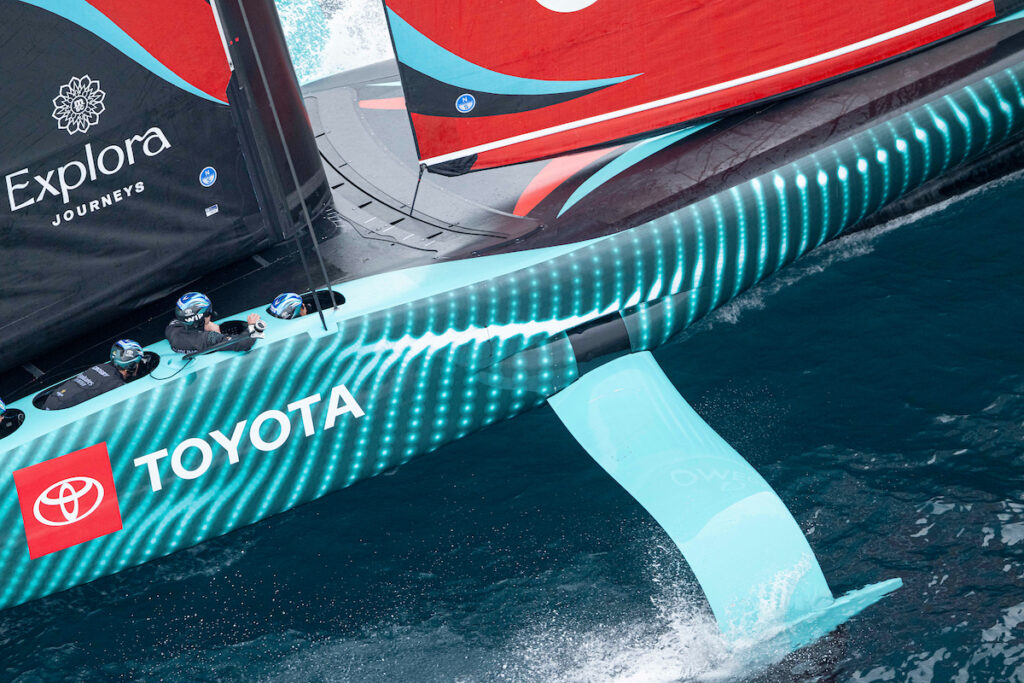 The final foil package for Emirates Team New Zealand is said to be smaller in profile for both rudder and wings, and even in the light winds of the first two races, the Kiwis had no issues with maneuvers once on foil.
Ricardo Pinto/America’s Cup
The final foil package for Emirates Team New Zealand is said to be smaller in profile for both rudder and wings, and even in the light winds of the first two races, the Kiwis had no issues with maneuvers once on foil.
Ricardo Pinto/America’s Cup
New Zealand owned the first cross, but only by a half a length, and INEOS’s duck allowed them to get right. The Kiwis, however, controlled the next cross by half a boatlength, which set them up for a straight shot into the gate on starboard, rounding the left gate and continuing on toward lighter breeze. INEOS, only 11 seconds behind, rounded the opposite gate and hooked into a wind line that gave the British control of the race at the next intersection.
The better move, Moloney confessed after racing, would have been to jibe sooner after the rounding. “In hindsight, we probably would have done an earlier jibe,” he said, “and that was definitely a mistake, but it was hard to get it all right today.”
But INEOS’s lead was fleeting. New Zealand owned the next cross and led through the first leeward gate by only 9 seconds. Bouncing boundary to boundary, Team New Zealand had firm control of the race, with INEOS making gains wherever they could, narrowing the Kiwi lead to a half-boat length at the second leeward gate.
Ainslie shared that they lost control of the rudder during rounding as they jibed and tried to create another split. New Zealand, showing an even better ability to maneuver without much speed loss, was able to then cover and truly lock down the match from there.
“We’ve been working on the tricky maneuvers and we executed them well,” Maloney said, “but today was about being in the right place on the course at the right time rather than boatspeed or foil-package differences. It would have been very hard for us to get past them if they were ahead of us off the line and sailing better than us.”
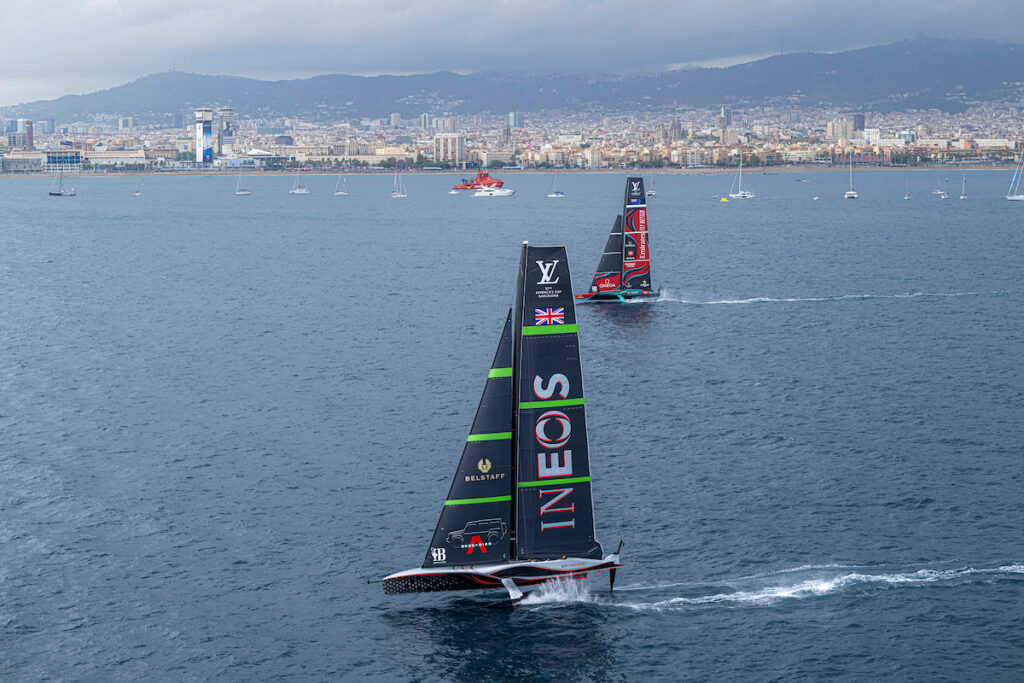 Looking for split whenever they could, INEOS Britannia could find no passing lane on the upwind legs.
Ricardo Pinto/America’s Cup
Looking for split whenever they could, INEOS Britannia could find no passing lane on the upwind legs.
Ricardo Pinto/America’s Cup
Ainslie said his team had their moments and that “we showed that if we sail well and can get ourselves stuck in we can beat them. It wasn’t the start we wanted. The performance was close enough that we can make some gains in areas where they are perhaps doing a slightly better job than us, make those gains and get some wins on the board and take this series all the way.
“Their maneuvers, their tacking, was good, they look pretty slippery. They are doing a better job of getting up to speed out of the tacks, but we’ve shown as a team that we are good at learning and if there’s something we need to improve on we can figure that out.”
The post Emirates Team New Zealand Two for Two in America’s Cup Opener appeared first on Sailing World.
- Home
- About Us
- Write For Us / Submit Content
- Advertising And Affiliates
- Feeds And Syndication
- Contact Us
- Login
- Privacy
All Rights Reserved. Copyright , Central Coast Communications, Inc.